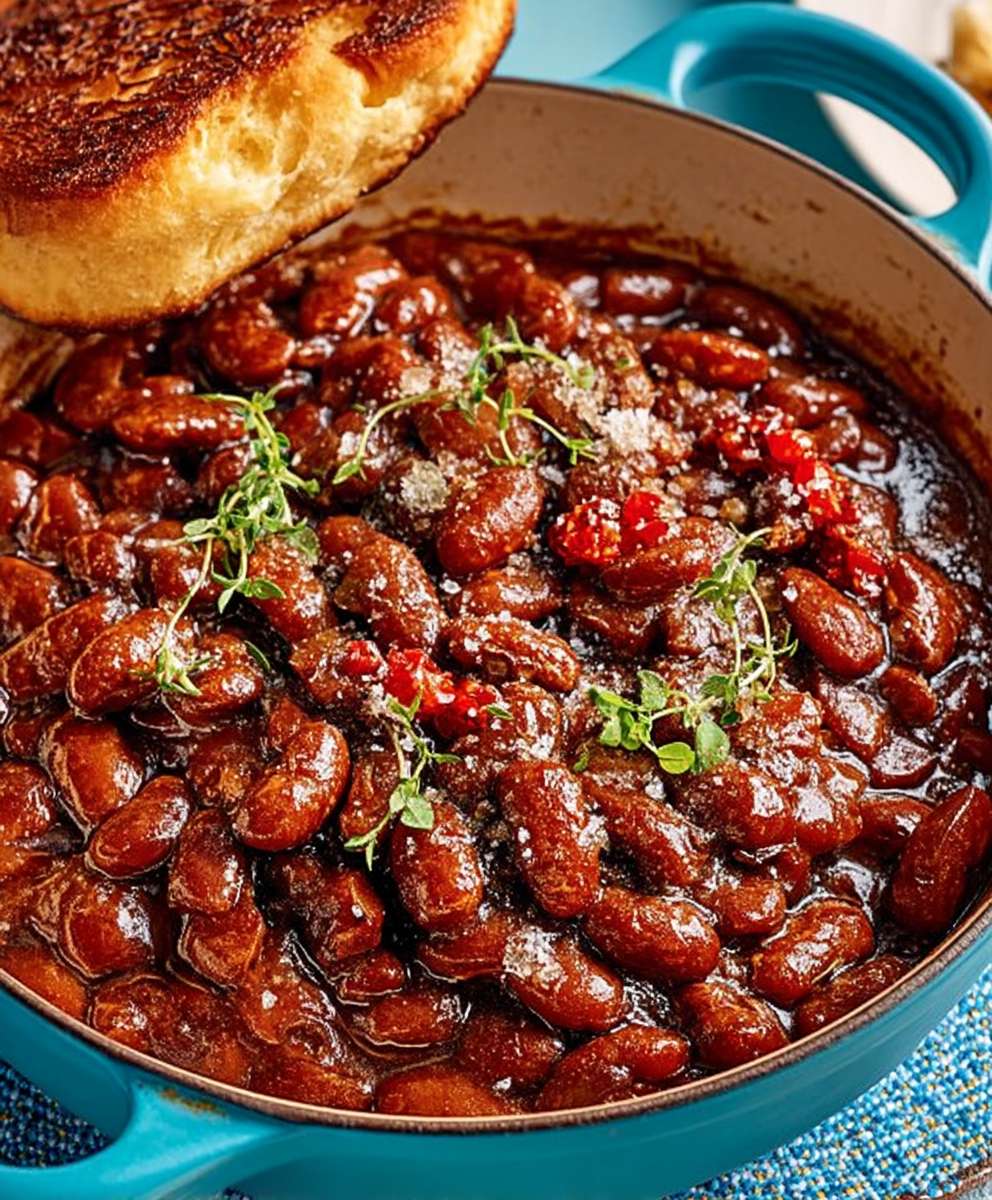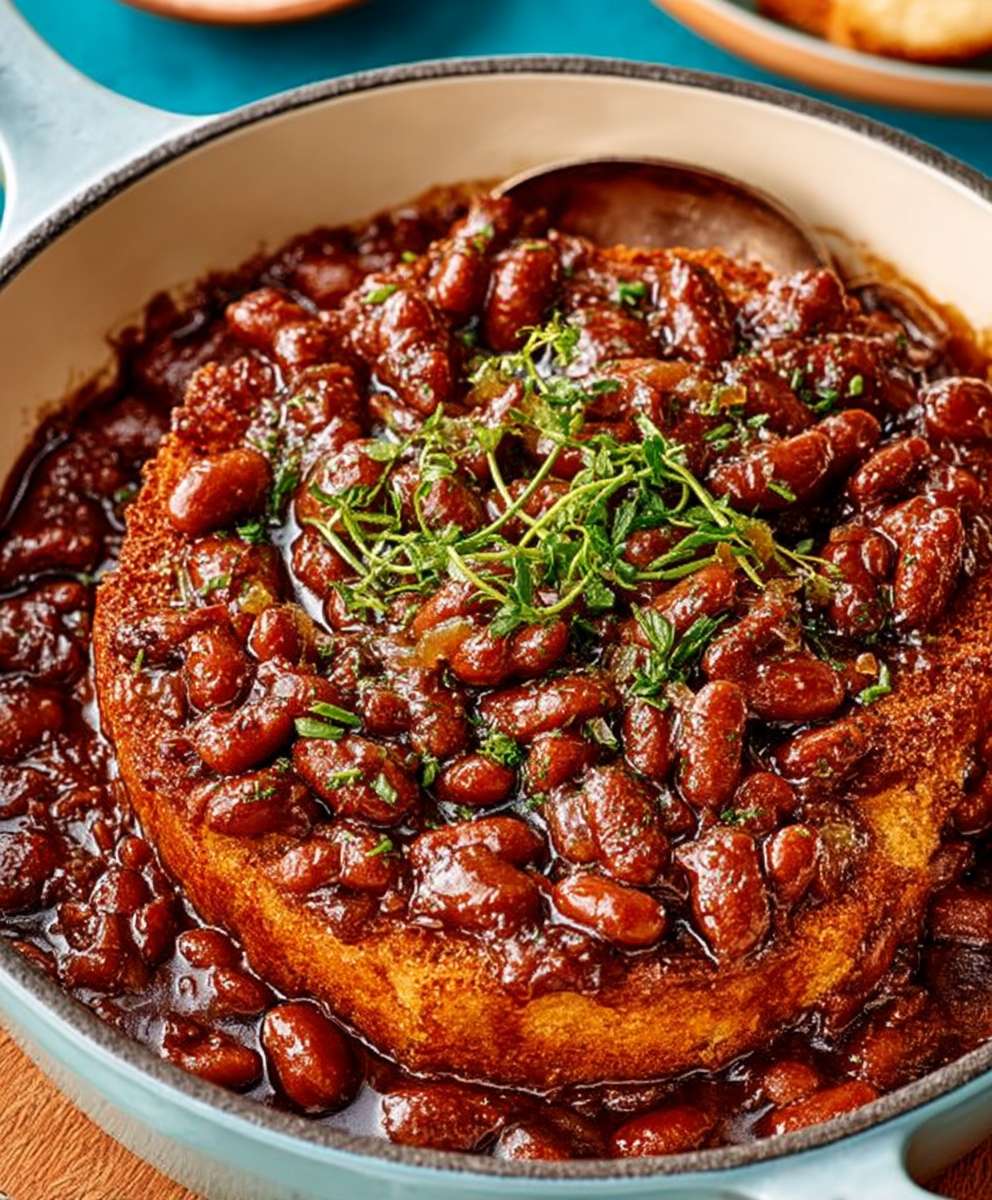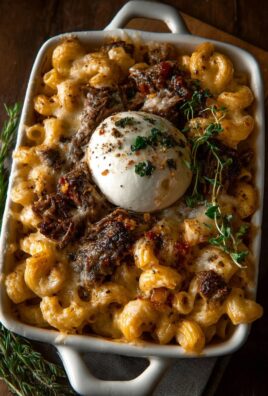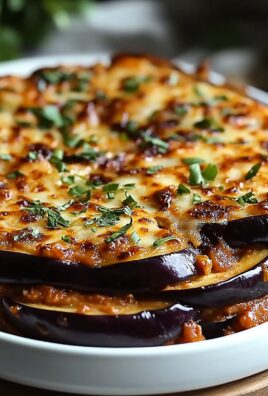Boston Baked Beans: the very name conjures up images of cozy New England kitchens, the aroma of molasses and smoky bacon wafting through the air. Have you ever craved a dish thats both hearty and sweet, a culinary hug in a bowl? Then look no further! This iconic dish is more than just beans; it’s a taste of history, a symbol of resourcefulness, and a testament to the enduring appeal of simple, honest food.
The story of Boston Baked Beans is deeply intertwined with the history of Boston itself. Native American tribes were already using beans as a staple food, and early colonists quickly adopted them, adding their own twist with readily available ingredients like molasses (a byproduct of the rum trade) and salt pork. The tradition of baking beans on Saturday and enjoying them on Sunday, when cooking was discouraged for religious reasons, further cemented its place in New England culture.
But why do people still love this classic dish? It’s the perfect blend of sweet and savory, the soft, yielding texture of the beans contrasting beautifully with the crispy bits of bacon. It’s also incredibly convenient a one-pot meal that’s perfect for feeding a crowd or enjoying as leftovers. Plus, let’s be honest, there’s something incredibly comforting about a warm bowl of Boston Baked Beans on a chilly evening. So, are you ready to experience a true taste of New England? Let’s get cooking!
Ingredients:
- 1 pound (about 2 cups) dried navy beans
- 6 cups water, plus more for soaking
- 1/2 pound salt pork, rind scored
- 1 large yellow onion, chopped
- 1/2 cup molasses (unsulphured)
- 2 tablespoons brown sugar, packed
- 1 tablespoon Dijon mustard
- 1 teaspoon dry mustard
- 1/2 teaspoon black pepper
- 1/4 teaspoon ground ginger
- 1/4 teaspoon ground cloves
- 1/2 teaspoon salt (or to taste, be mindful of the salt pork)
Preparing the Beans:
- Soaking the Beans: First things first, we need to rehydrate those dried navy beans. Place the beans in a large bowl or pot. Cover them with at least 6 cups of cold water, ensuring the water level is well above the beans (they’ll expand!). Let them soak for at least 8 hours, or preferably overnight. This step is crucial for even cooking and preventing tough beans. I usually start this the night before I plan to make the beans.
- Draining and Rinsing: After soaking, drain the beans in a colander and rinse them thoroughly under cold running water. This helps remove any impurities and excess starch released during soaking. Give them a good shake to remove as much water as possible.
- Parboiling the Beans: Now, we’re going to parboil the beans. Place the drained beans in a large pot or Dutch oven. Add 6 cups of fresh water. Bring the water to a boil over high heat. Once boiling, reduce the heat to a simmer, cover the pot, and let the beans simmer gently for about 30 minutes. This pre-cooking step helps to soften the beans and ensures they cook evenly in the oven later. Keep an eye on the water level and add more if needed to keep the beans covered.
- Draining Again: After simmering, drain the beans again in a colander. Reserve about 1 cup of the cooking liquid we’ll use this later to add moisture and flavor to the beans.
Preparing the Salt Pork:
- Scoring the Rind: The salt pork is a key ingredient that adds a rich, smoky flavor to the baked beans. Take your 1/2 pound of salt pork and, using a sharp knife, score the rind in a crosshatch pattern. This helps the fat render out during cooking and infuses the beans with its delicious flavor. Be careful not to cut too deeply into the meat.
- Browning the Salt Pork (Optional): While not strictly necessary, browning the salt pork before adding it to the beans can enhance its flavor even further. In a skillet over medium heat, cook the scored salt pork until it’s lightly browned on all sides. This step is optional, but I find it adds a nice depth of flavor. If you choose to skip this step, just add the salt pork directly to the pot with the beans.
- Cutting the Salt Pork: After browning (or not!), cut the salt pork into 1/2-inch cubes. This will allow the flavor to distribute evenly throughout the beans.
Assembling and Baking the Beans:
- Combining Ingredients: In a large Dutch oven or oven-safe pot (at least 4-quart capacity), combine the parboiled beans, cubed salt pork, chopped onion, molasses, brown sugar, Dijon mustard, dry mustard, black pepper, ground ginger, ground cloves, and salt. Stir well to ensure all the ingredients are evenly distributed.
- Adding Reserved Liquid: Pour the reserved 1 cup of bean cooking liquid over the mixture. This will help keep the beans moist during baking. If you don’t have enough reserved liquid, you can add a little water. The liquid should just barely cover the beans; add more if needed.
- Baking: Cover the Dutch oven tightly with a lid. Bake in a preheated oven at 300°F (150°C) for 6-8 hours, or until the beans are tender and the sauce has thickened. Check the beans periodically (every 2-3 hours) and add more water or bean broth if they seem dry. The goal is to have a rich, thick sauce, not dry beans.
- Uncovering (Optional): During the last hour of baking, you can remove the lid to allow the top of the beans to brown slightly and the sauce to thicken further. Keep a close eye on them to prevent them from drying out. If they start to look too dry, cover them again.
- Resting: Once the beans are done, remove the Dutch oven from the oven and let them rest for at least 30 minutes before serving. This allows the flavors to meld together and the sauce to thicken even more.
Tips and Variations:
- Bean Selection: While navy beans are traditional, you can also use other types of beans, such as Great Northern beans or pea beans. The cooking time may vary slightly depending on the type of bean you use.
- Sweetness Adjustment: Adjust the amount of molasses and brown sugar to your liking. Some people prefer a sweeter bean, while others prefer a more savory flavor.
- Spice Variations: Feel free to experiment with other spices, such as smoked paprika, chili powder, or a pinch of cayenne pepper, to add a little heat.
- Vegetarian Option: For a vegetarian version, omit the salt pork and use vegetable broth instead of water. You can add a tablespoon of smoked paprika to mimic the smoky flavor of the salt pork. You can also add a few drops of liquid smoke.
- Slow Cooker Method: You can also make these beans in a slow cooker. After parboiling the beans and preparing the salt pork, combine all the ingredients in the slow cooker. Cook on low for 8-10 hours, or on high for 4-5 hours, or until the beans are tender.
- Adding Tomatoes: Some recipes call for adding a can of diced tomatoes or tomato paste to the beans. This adds a touch of acidity and sweetness. If you want to try this, add a 14.5-ounce can of diced tomatoes or 2 tablespoons of tomato paste along with the other ingredients.
- Serving Suggestions: Boston baked beans are traditionally served with brown bread and hot dogs. They’re also a great side dish for barbecued meats, cornbread, or coleslaw.
- Storage: Leftover baked beans can be stored in an airtight container in the refrigerator for up to 3-4 days. They can also be frozen for longer storage. Reheat gently on the stovetop or in the microwave.
- Salt Pork Alternatives: If you can’t find salt pork, you can use bacon or pancetta as a substitute. Cook the bacon or pancetta until crispy, then crumble it and add it to the beans.
- Molasses Type: I recommend using unsulphured molasses for the best flavor. Blackstrap molasses has a stronger, more bitter flavor, so use it sparingly if you choose to use it.
- Water Hardness: Hard water can sometimes affect the cooking time of beans. If you have hard water, you may need to soak the beans for a longer period of time or add a pinch of baking soda to the soaking water.
Enjoy your homemade Boston Baked Beans! They’re a classic New England dish that’s perfect for a cozy night in.

Conclusion:
So, there you have it! This Boston baked beans recipe isn’t just another bean dish; it’s a flavorful journey back in time, a comforting hug in a bowl, and a guaranteed crowd-pleaser. From the rich molasses sweetness to the savory bacon undertones, every spoonful is an explosion of deliciousness. I truly believe this is a must-try recipe for anyone who appreciates hearty, home-cooked meals.
Why is it a must-try? Because it’s more than just beans! It’s about creating a dish that’s both satisfying and deeply flavorful. The slow cooking process allows the flavors to meld together beautifully, resulting in a depth of taste that you simply can’t achieve with quicker methods. Plus, the aroma that fills your kitchen while these beans are simmering is simply divine it’s the scent of comfort and home.
But the best part? This recipe is incredibly versatile! While I love serving these beans as a classic side dish with grilled sausages, cornbread, or coleslaw, there are so many other ways to enjoy them. For a heartier meal, try serving them over toast with a fried egg on top. Or, get creative and use them as a filling for tacos or burritos. They’re also fantastic as part of a baked potato bar, offering a sweet and savory alternative to traditional toppings. And for a truly authentic experience, serve them alongside some brown bread the perfect complement to the rich, sweet flavor of the beans.
Looking for variations? Feel free to experiment with different types of beans. Navy beans are traditional, but Great Northern beans or even pinto beans would work well too. You can also adjust the sweetness to your liking by adding more or less molasses. For a spicier kick, try adding a pinch of cayenne pepper or a dash of hot sauce. And if you’re not a fan of bacon, you can substitute it with salt pork or even smoked turkey. The possibilities are endless!
Serving Suggestions:
- Alongside grilled sausages or hot dogs
- With cornbread and coleslaw for a classic BBQ meal
- Over toast with a fried egg for a hearty breakfast
- As a filling for tacos or burritos
- As part of a baked potato bar
- With brown bread for an authentic New England experience
Variations:
- Experiment with different types of beans (Great Northern, pinto)
- Adjust the amount of molasses to your liking
- Add a pinch of cayenne pepper or hot sauce for a spicy kick
- Substitute bacon with salt pork or smoked turkey
I’m so excited for you to try this recipe and experience the magic of homemade Boston baked beans for yourself. I poured my heart into perfecting this recipe, and I truly believe you’ll love it as much as I do. So, gather your ingredients, put on some good music, and get ready to create a dish that will become a family favorite for years to come.
And now, the most important part: I want to hear from you! Once you’ve tried this recipe, please come back and share your experience in the comments below. Did you make any variations? What did you serve it with? What did your family think? I’m eager to hear your stories and see your creations. Happy cooking!
Boston Baked Beans: A Classic Recipe and History
Classic Boston Baked Beans, slow-cooked with salt pork, molasses, and spices. A hearty New England staple.
Ingredients
- 1 pound (about 2 cups) dried navy beans
- 6 cups water, plus more for soaking
- 1/2 pound salt pork, rind scored
- 1 large yellow onion, chopped
- 1/2 cup molasses (unsulphured)
- 2 tablespoons brown sugar, packed
- 1 tablespoon Dijon mustard
- 1 teaspoon dry mustard
- 1/2 teaspoon black pepper
- 1/4 teaspoon ground ginger
- 1/4 teaspoon ground cloves
- 1/2 teaspoon salt (or to taste, be mindful of the salt pork)
Instructions
- Place beans in a large bowl or pot. Cover with at least 6 cups of cold water. Soak for at least 8 hours, or preferably overnight.
- Drain the soaked beans in a colander and rinse thoroughly under cold running water.
- Place drained beans in a large pot or Dutch oven. Add 6 cups of fresh water. Bring to a boil, then reduce heat to a simmer, cover, and simmer gently for about 30 minutes. Drain again, reserving 1 cup of the cooking liquid.
- Score the rind of the salt pork in a crosshatch pattern. Optionally, brown the salt pork in a skillet over medium heat until lightly browned on all sides. Cut the salt pork into 1/2-inch cubes.
- In a large Dutch oven or oven-safe pot, combine the parboiled beans, cubed salt pork, chopped onion, molasses, brown sugar, Dijon mustard, dry mustard, black pepper, ground ginger, ground cloves, and salt. Stir well.
- Pour the reserved 1 cup of bean cooking liquid over the mixture. Add more water if needed to just barely cover the beans.
- Cover the Dutch oven tightly with a lid. Bake in a preheated oven at 300°F (150°C) for 6-8 hours, or until the beans are tender and the sauce has thickened. Check periodically and add more water or bean broth if they seem dry.
- During the last hour of baking, remove the lid to allow the top of the beans to brown slightly and the sauce to thicken further.
- Remove from oven and let rest for at least 30 minutes before serving.
Notes
- Bean Selection: Navy beans are traditional, but Great Northern or pea beans can be used. Cooking time may vary.
- Sweetness Adjustment: Adjust molasses and brown sugar to taste.
- Spice Variations: Experiment with smoked paprika, chili powder, or cayenne pepper.
- Vegetarian Option: Omit salt pork and use vegetable broth. Add smoked paprika or liquid smoke.
- Slow Cooker Method: Combine all ingredients in a slow cooker after parboiling. Cook on low for 8-10 hours, or on high for 4-5 hours.
- Adding Tomatoes: Add a 14.5-ounce can of diced tomatoes or 2 tablespoons of tomato paste.
- Serving Suggestions: Serve with brown bread and hot dogs, barbecued meats, cornbread, or coleslaw.
- Storage: Store leftovers in an airtight container in the refrigerator for up to 3-4 days or freeze for longer storage.
- Salt Pork Alternatives: Use bacon or pancetta as a substitute.
- Molasses Type: Use unsulphured molasses for the best flavor.
- Water Hardness: Hard water may require longer soaking or a pinch of baking soda in the soaking water.





Leave a Comment